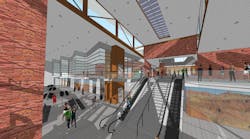FLAGSTAFF, Ariz. (AP) — A proposal to build a much larger terminal at Grand Canyon National Park Airport would allow for commercial passenger flights to the area and could boost the number of visitors to the airport to as many as 1 million each year, an Arizona transportation official said Tuesday.
The airport logged more than 318,000 passengers in 2010, and almost all of that traffic was related to aerial tours of the canyon on smaller aircraft. In 2008, air tours made up 95 percent of the airport's operations, according to a study on terminal plans.
Building a bigger terminal would meet security and baggage requirements for commercial airlines, said Laura Douglas, a state Department of Transportation spokeswoman.
"This will allow people to book their own tours, their own packages and get to the airport a lot more frequently and see one of Arizona's biggest draws," she said.
Visitors from across the country typically take ground transportation into the park or fly into Las Vegas-area airports before boarding smaller planes to the Grand Canyon airport. But the Department of Transportation wants to bring in flights from other major hubs, such as Denver, she said.
Expanding the existing 8,850 square-foot terminal, located just south of the national park, would cost $10 million and could take five years. The project would be paid for with a mix of state, federal and private funding, though the Federal Aviation Administration said the airport has yet to apply for any federal grants.
The airport has been a money-losing operation for the state in recent years. The Transportation Department brings in between $900,000 and $1 million annually but spends up to $1.5 million. Recently approved increases in landing, gate and parking fees are expected to raise $250,000 a year but that won't cover the deficit.
Restaurants, hotels and other commercial development not directly tied to aviation could come through public and private partnerships, Douglas said.
The timeframe for the terminal aligns with a major development plan proposed in the nearby town of Tusayan that would create 3 million square-feet of commercial space and hundreds of new homes. But the Transportation Department said the projects are unrelated, though few doubt they would not be mutually beneficial.
Park officials said they're concerned a new terminal would mean more noise at a time when they're trying to manage the number of flights over the park and make the environment quieter.
Visitation to the park has remained relatively flat at 4.5 million annually, but parking shuttles from Tusayan are routinely crowded, and the parks' facilities are overwhelmed, park Superintendent Dave Uberuaga said.
"I haven't seen any actions that would indicate a sensitivity for what is too much," he said.
Douglas said the department is looking at the environmental impacts of expanding the airport.
LEA-Architects, LLC, which is designing the terminal, said it would incorporate sustainable aspects, such as solar power, water harvesting, low-flow plumbing and recycled materials.






